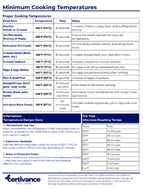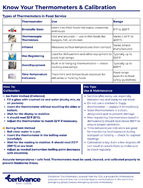In the kitchen, precision matters—and when it comes to food temperatures, it could mean the difference between safety and illness. Improper cooking or inaccurate thermometer readings are common culprits in foodborne outbreaks. This guide ensures your team is equipped to measure correctly, cook thoroughly, and serve safely.
Why Temperature Accuracy Is Critical
- Bacteria thrive in the “danger zone” (40°F – 140°F).
- Undercooked proteins like poultry, beef, and seafood can carry harmful pathogens like Salmonella and E. coli.
- Protecting your guests starts with knowing the safe zones.
Mastering Thermometers
- Types of thermometers (digital, dial, infrared) and when to use them.
- Why regular calibration is non-negotiable.
- Step-by-step: how to calibrate using ice water and boiling water methods.
Minimum Cooking Temperatures Made Easy
- Ground beef: 160°F
- Chicken & poultry: 165°F
- Fish: 145°F
- Reheated leftovers: 165°F
(A complete breakdown is included in the downloadable chart.)
Minimum Cooking Temperatures - Poster
Know your Thermometers & Calibration - Poster











